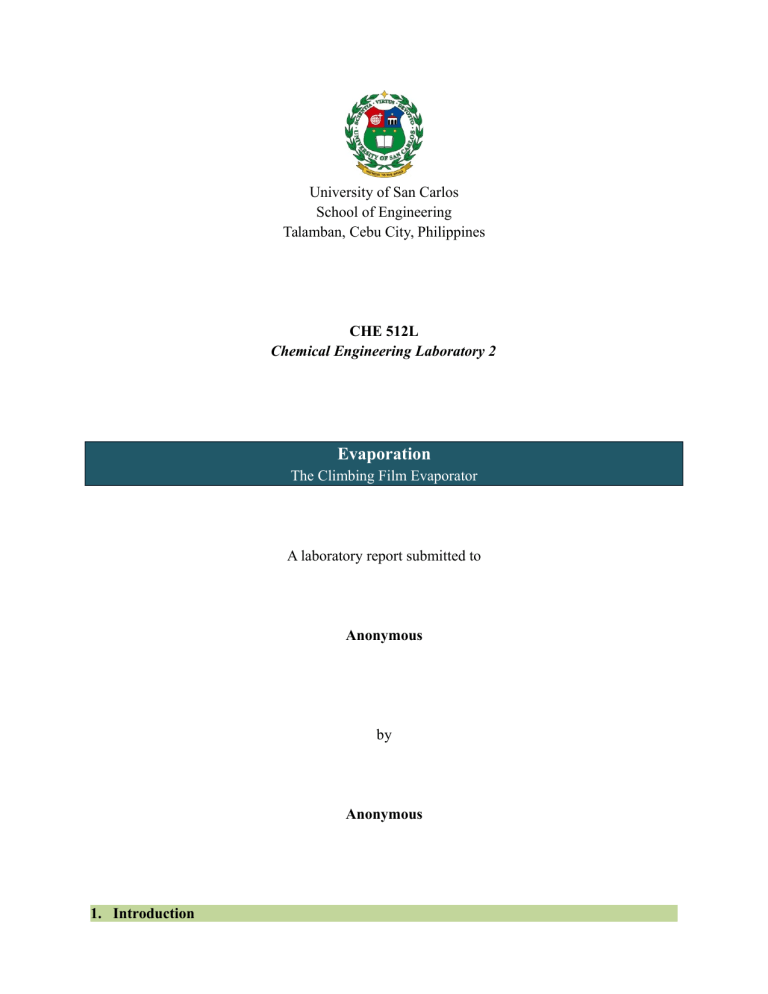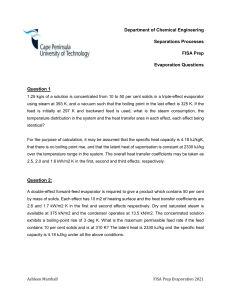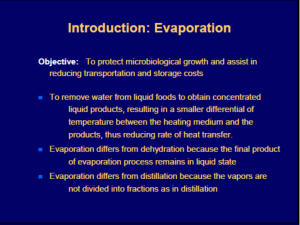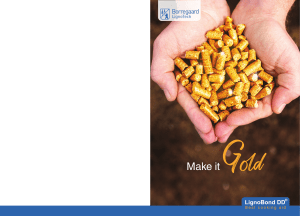
University of San Carlos School of Engineering Talamban, Cebu City, Philippines CHE 512L Chemical Engineering Laboratory 2 Evaporation The Climbing Film Evaporator A laboratory report submitted to Anonymous by Anonymous 1. Introduction One of the important unit operations that make use of heat transfer through boiling is evaporation. In this operation, a liquid solution is heated until it boils and the vapor is removed from the remaining solution, which is then more concentrated. This solution, referred to as concentrate, is usually the desired product in the cases of some aqueous solutions of sugar, milk, and orange juice (Geankoplis, 2003). Among the factors considered during evaporation are the concentration in the liquid, solubility, foaming or frothing, deposition of scale, temperature sensitivity of the solution, and the temperature and pressure of the evaporator. In addition, there are many types of evaporators which generally vary on the configuration of the heat transfer surface and the agitation or circulation of the liquid (Geankoplis, 2003). Evaporators may have feed flowing through natural circulation, forced circulation or by gravity, and may flow in horizontal or vertical tubes. Figure 1 is a simplified diagram of a single-stage evaporator. The feed enters at a temperature of TF, has a concentration of x F, and carries an enthalpy of h F. The temperature and pressure in the evaporator are the boiling point and saturation vapor pressure, respectively, of the concentrate L, which leaves at concentration xF and enthalpy hL. The vapor leaves with an enthalpy of H V. Both vapor and concentrate have the same temperature and pressure as the evaporator. The steam enters at a temperature T S with enthalpy HS and leaves with enthalpy h S. Assuming that the steam is saturated vapor and the only heat given off is latent heat, the difference in enthalpy is simply the latent heat of vaporization λ. Vapor V T1,, HV Feed F TF, xF, hF P1, T1 Condensate S TS, hS Steam S TS, HS Concentrate L T1, xL, hL Figure 1. Diagram of a single-stage evaporator 2 The overall and component mass balances, and the heat balance are as shown in the equations below. F L V Fx F Lx L (1) (2) FhF S ( H S hS ) LhL VH V (3) The heating rate due to condensing steam can be expressed in the form of the heat flux equation in terms of the overall heat transfer coefficient: Q S ( H S hS ) S UAT (4) In the equation, ΔT is the temperature difference between the steam and boiling liquid while A is the heat transfer area. The overall heat transfer coefficient U is composed of the steam-side condensing coefficient, the tube thermal conductivity, and the heat-side boiling coefficient. The resistance offered by the wall is often neglected (Geankoplis, 2003). The steam-side condensing coefficient can be estimated using Nusselt’s model assuming film condensation. Correlations for boiling coefficient are also provided, one of which is the Mostinsky’s correlation (Serth, 2007). In the actual operation, formation of scales and deposits due to decrease in solubility or decomposition of solute can affect the heat transfer coefficient and also lower the amount of solute in the concentrate. 3 2. Objectives of the Experiment 1. Investigate the effect of the feed rate on the evaporator product concentration. 2. Investigate the effect of the operating steam pressure on the rate of evaporation. 3. Determine the overall heat transfer coefficient of the calandria and compare with values predicted from empirical correlations. 4. Perform steady-state mass balance over the evaporator system to estimate mass losses during the evaporation operations conducted. 3. Methodology 3.1. Methodological Framework Objectives 1 and 2 concerned the relationships between evaporator stream properties. Information about parameters set constant, the number of variations, methods of determining the dependent variables and the hypothesized relationships between independent and dependent variables are summarized in Figure 2. Evaporator operating pressure Steam pressure Feed inlet temperature Feed concentration Constant Evaporator operating pressure Feed rate Feed inlet temperature Feed concentration PRODUCT CONCENTRATION Method of evaluation: mass balance hypothesized to: decrease with increasing feed rate Independe nt Dependent OPERATING STEAM PRESSURE values: 5 psig, 10 psig RATE OF EVAPORATION Method of evaluation: measurement hypothesized to: increase with increasing operating steam pressure FEED RATE number of variations: 1 Figure 2. Research variables for Objectives 1 and 2. The output of Objective 3 was to provide a comparison between experimental and predicted calandria overall heat transfer coefficients. Provided in Figure 3 are approaches to evaluating the overall heat transfer coefficient. 4 P re d ic t e d Evaluated using empirical correlations Assumed two resistances based on phenomena of steam-side condensation and feed-side boiling in a vertical tube Evaluated using the heat flux equation Q = UAΔT The heating rate is determined from experimental data gathered Figure 3. Framework for the determination of overall heat transfer coefficients Objective 4 saw the construction of steady-state mass balances, inputting the mass flow rates of streams which were determined using volume and density measurements. These were then used to evaluate the operability of the equipment. 3.2. Materials A sugar solution was prepared using 1 kg of brown sugar and 15 liters of distilled water. This solution served as the feed for the evaporator. Steam is supplied from a steam generator and tap water for the condenser is supplied from a tap water line. 3.3. Equipment The key equipment used in the experiment is a climbing film evaporator. This evaporator is a long-tube vertical evaporator using vacuum to induce forced circulation of feed. This is used for heatsensitive solutions. The climbing-film evaporator consists of the calandria, where the feed is heated by steam to vaporize part of the liquid, a cyclone where the vapor and concentrated liquid separate, a condenser that cools the vapor to condensation, and receivers for both the concentrate and condensed vapor. The feed rate is controlled by the feed inlet valve. Operating steam pressure is manipulated by the steam supply valve at the steam line. The feed container and concentrate receiver are graduated to allow measurement of volume and a thermometer pocket at the top of the evaporator 5 allows the measurement of vapor temperature. The concentrate and the condensed vapor can be collected through drain valves at the bottom of their receivers and the condensed steam can be obtained through the steam discharge valve in the steam line. The operating pressure of the evaporator can be determined through the pressure gauge reading at the vacuum pump. 3.4. Procedures The feed was prepared by adding 1 kg of brown sugar to 15 liters of distilled water. The solution was heated to 60°C and its density was measured using a densitometer. Before the evaporator was operated, start-up procedures were done. Valves were lined up in their proper positions. The cooling water to the condenser was then allowed to flow through the cooling coil and the feed inlet to the evaporator was connected to feed receiver through a hose. After the start-up operation, the vacuum pump was started and steam was then allowed to flow through the steam jacket, flushing out any non-condensable vapor and water in the evaporator. Finally, the feed was allowed to flow through the equipment. The evaporator was allowed to equilibrate for five minutes and then the height of the liquid in the calandria was measured. After the evaporator was running smoothly for some time, an arbitrary 15-minute period was set for the determination of the following quantities in the feed, concentrate, and vapor: temperature, flow rate, and density. The flow rate was determined by measuring the volume collected /lost during the measurement period. Temperature data were obtained using an alcohol thermometer and the densities were measured using a densitometer. 6 4. Results and Discussions 4.1 Effect of the feed rate on the evaporator product concentration A bar graph of feed flow rate versus product concentration was constructed to infer the effect of the former on the latter. The data gathered was a result of two 15-minute runs conducted with varying feed flow rate, F. Figure 2 shows the bar graph of feed flow rate versus product concentration. 0.12 0.10 0.08 product concentration, xL (g/mL) 0.06 0.04 0.02 0.00 77.6 101.22 feed flowrate, F (g/min) Figure 4. Product concentration, xL as a function of feed flowrate, F From Figure 2, it can be noted that at a higher feed flow rate, the product concentration increases. This trend is contrary to what was hypothesized. At higher feed flow rates, the concentration of the product should be less compared to the concentration of the product at the lower feed flow rate. This can be attributed to the mass and heat balance. If the feed flow rate is higher, more heat is needed to vaporize the liquid in the solution. The deviation of the acquired data from the expected trend may be attributed to the following factors: the delay in making the density measurements, insufficient washing of the concentrate receiver from the second run, the inaccurate measurements of the volumetric feed rate and the fluctuating steam operating pressure and feed temperature. There is a peculiar phenomenon, however, that may have been the main reason why the results are not as expected: both runs are at 5 psig but the steam flow rate is 70.67 ml/min for the run with the lower feed flow rate and 120.67 ml/min for the run with the higher feed flow rate. With this in effect, the heat rate was not kept constant throughout the experiment. This large difference in steam flow rate may have resulted to more liquid being evaporated, thus giving 7 a higher concentration for the run with the higher feed flow rate. Thus, whether or not the hypothesis holds true remains unclear. 4.2 Effect of the operating steam pressure on the rate of evaporation In investigating the effect of steam pressure setting on the rate of evaporation, two 15minute runs were conducted. One of which was already done in the first objective. A bar graph showing the results of the two runs can be seen in Figure 5. 35.00 30.00 25.00 20.00 rate of evaporation, V (g/min) 15.00 10.00 5.00 0.00 5 10 steam pressure setting (psig) Figure 5. Rate of evaporation, V as a function of steam operating pressure It can be noted from the graph that at the higher steam pressure setting, the rate of evaporation is higher as well. This can also be attributed to the heat balance. A higher steam pressure means that there is more steam flowing through the steam jacket. With a higher steam flow rate, more heat can be supplied to vaporize the liquid in the feed, hence the higher rate of evaporation. 4.3 Experimental and Predicted Overall Heat Transfer Coefficients: The overall heat transfer coefficient of the calandria wall was calculated using both experimental data and empirical correlations. The results are shown on the table below. Table 1. Actual and Theoretical Overall Heat Transfer Coefficients Run Uact (W/m2·K) Utheo (W/m2·K) % diff 8 1 2 3 6,716.58 9,857.68 10,560.04 5222.50 5753.35 5022.80 28.61 71.34 110.24 It can be noted that the estimated heat transfer coefficient is much lower than the actual heat transfer coefficient as evident from the percent differences. This means that the theoretical resistance to heat transfer was predicted to be higher than the actual resistance. In addition, the actual heat transfer coefficients varied widely between runs. The differences of U between theoretical and actual values may have been due to the correlations used and the differences of U between runs may have been due to large differences in values of liquid height and steam flow rate for Runs 1 and 3. The experimental overall heat transfer coefficient was calculated using the equation for heat transfer flux, Q=UAΔT. It was assumed that only latent heat was transferred from the steam to the sugar solution. The temperature difference is that of between the feed and the saturation temperature of the steam. The area for heat transfer was based on the liquid level of the feed in the calandria. During the run, it was observed that the liquid level was different for the three runs. For Run 2, the liquid level was lower at 0.1050m compared to Runs 1 and 2 which are at 0.1550m and 0.1800m, respectively. This, including the difference in steam flow rate for Runs 1 and 2, lead to the difference in heat transfer coefficients between the runs. The theoretical overall heat transfer coefficient, determined using empirical correlations, was estimated considering two resistances, the steam side and the feed side heat transfer coefficients. It was assumed that the wall of the calandria is so thin that it posed negligible resistance to heat transfer; resistance to heat transfer by conduction is not included in the equation. In the outside wall of the calandria, steam condenses as it comes into contact with the wall. It then flows down the tube as a thin film of liquid. The heat transfer coefficient for the this side, the steam side, was calculated using Nusselt’s model (Butterworth, 1977; Serth, 2007), noting that what is happening is condensation (assumed to be film condensation) on the outside walls of a vertical tube. Inside the calandria, the sugar solution flowing up the tube by pressure difference is heated by the steam and boils. Part of the water in the liquid is vaporized. The vapor and the remaining liquid flow up the column with the liquid forming a thin film on the wall of the tube. This can be considered as forced convection boiling. 9 The heat transfer coefficient for the feed side was estimated using Chen’s method (Butterworth, 1977) which states that the coefficient is the sum of two heat transfer coefficients, the forced convection heat transfer coefficient (calculated as if only the liquid is flowing through the tube) and a nucleate boiling heat transfer coefficient. A correction factor is applied to this component as forced convection suppresses boiling (Perth, 2007). The forced convection heat transfer coefficient was calculated using Dittus-Boelter’s equation while the nucleate boiling heat transfer coefficient was estimated using Mostinsky’s correlation as provided by Serth. The same author also provided Chen’s equation relating these to the convective boiling heat transfer coefficient. Serth also illustrated that different correlations for nucleate boiling heat transfer may lead to differing estimated heat transfer coefficients and could vary at factors as great as 20. Thus, using different correlations aside from Mostinsky’s may lead to different theoretical overall heat transfer coefficients and may result to estimates close or even higher than the actual overall heat transfer coefficient. 4.4 Mass losses during evaporator operation: Assuming the evaporator has already been running on steady state conditions, it is expected that the amount of feed entering the evaporator is equal to the amount that exits. These would be the condensate and concentrate. However, by doing mass balance using actual experimental data, the amount of feed entering minus the amount exiting doesn’t equate to zero. The resulting value is the mass loss or gain in the system. mloss F L V (5) Table 2 shows the values calculated for the mass losses. For the first two runs, we lost 0.0896 kg and 0.0607 kg of the solution, respectively. The third run had a gain of 0.1831 kg of the solution. 10 Table 2. Mass losses at different runs Run 1 2 3 Mass Losses (kg) 0.0896 0.0607 -0.1831 The results may be explained by (1) human and instrumental error, and (2) sucrose losses across the evaporator. The data gathered during the run of the experiment are more or less approximates. The instruments used for measuring volume are also not completely accurate; the feed container uses a pail manually calibrated for every half liter. When determining the densities of the streams, they may have cooled off by a few degrees compared to the actual temperature of the stream when it exited or entered the system, adding to the error. This may lead to some losses or gains during the calculation of the masses. It is also possible that the losses or gains are due to the equipment & the operation themselves. Another factor that could cause the mass loss is scaling in the evaporator. Sucrose can form scales in the evaporator. As a result, some of the sucrose are unable to exit the evaporator becoming unaccounted for in the mass balance (Eggleston, Damms, Monge, & Endres, 2004). This is also affected by the quality of the sugar used. 5. Conclusions The hypothesized relation that increasing flow rate decreases product concentration is still inconclusive due to the steam flow rate not being held constant between the runs. However, the hypothesis that increasing operating steam pressure increases rate of evaporation is supported by the results in the experiment. The values of the actual overall heat transfer coefficient of the calandria in terms of W/m2·K were determined to be 6,716.58, 9,857.68, and 10,560.04 for the first, second, and third run respectively. All of these coefficients were comparatively higher than those estimated using empirical correlations. From the steady state mass balances, mass losses were estimated to be 0.0896 kg for the first run and 0.0607 kg for the second run. The third run had a mass increase of 0.1831 kg. 11 References Butterworth, D. (1977). Introduction to Heat Transfer. Design Council. Cao, E. (2010). Heat Transfer in Processes Engineering. McGraw-Hill. Eggleston, G., Damms, M., Monge, A., & Endres, T. (2004). New insights on sucrose losses across factory evaporators and juice and syrup classifiers. SPRI 2004 Conference on Sugar Processing Research, 349370. Geankoplis, C. J. (2003). Principles of Transport Processes and Separation Processes (4th ed.). New Jersey, USA: Pearson Education, Inc. Serth, R. (2007). Processes Heat Transfer Principles and Applications. Elsevier Ltd. 12 ANNEX Data Processing and Analysis Report Revisions Revisions (Old values are enclosed in parentheses) Actual and Theoretical Heat transfer coefficients Run Uact (W/m2·K) Utheo (W/m2·K) 1 6,716.58 2 9,857.68 3 10,560.04 5222.50 (2421.92) 5753.35 (2444.75) 5022.80 (2749.34) 28.61 (177.32) 71.34 (303.22) 110.24 (284.09) A2.6 Theoretical overall heat transfer coefficient Steam operatin Evapora Effecti R φVC TS g tor ve u (mL/ (°C pressure Pressur height n min) ) , gauge e (kPa) (m) (psig) 33.60 0.155 108 1 5 70.67 0 .34 33.60 0.105 115 2 10 85.33 0 .21 33.60 0.180 126.6 108 3 5 0 7 .34 hs R (W/m· un K) 1 2 8476.0 4 8141.4 3 cp (kJ/kg ·K) 4.2517 4.2621 NPr 1.68 03 1.57 67 % diff hL (W/m ·K) 51.44 9 36.21 2 μC (kg/m· s) μs (kg/m· s) ρC (kg/ m3) ρs (kg/ m3 ) NRe, s NRe, L kC (W/ m·K) 2.70E04 2.53E04 2.70E04 1.33E05 1.36E05 1.33E05 996. 80 996. 00 102 6.60 0.58 39 0.57 39 0.58 39 221.8 201 285.5 768 409.4 886 190.3 406 126.4 787 189.9 396 0.682 0 0.682 9 0.682 0 P/Pc hnb (W/m· K) 1.52E03 (6.16E -03) 1.52E03 (7.72E -03) 13,964 .80 (2,330. 20) 20,452 .05 (2,675. 60) vapor mass fraction 0.14409 0.43833 Xtt 0.03 82 0.03 24 F(Xtt ) 26.1 419 29.4 822 SCH 0.87 80 0.90 68 hb (W/m ·K) Utheo (W/m2· K) 13605 .52 (3390. 81) 19614 .29 (3493. 93) 5222.50 (2421.9 2) 5753.35 (2444.7 5) 13 3 7046.5 7 4.2517 1.68 03 51.36 3 1.52E03 (6.16E -03) 18,643 .03 (3,475. 49) 0.52469 0.03 18 29.8 657 0.85 58 17488 .96 (4508. 36) 5022.80 (2749.3 4) Reasons for revision: 1. P/Pc: Value of P used was steam operating pressure but should be evaporator pressure 2. hnb: Erroneous calculation – Value of A used should be based on calandria level 14




